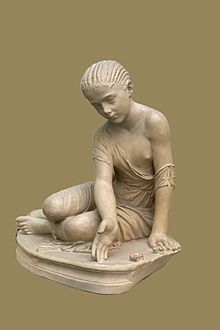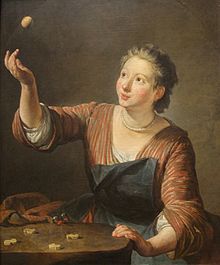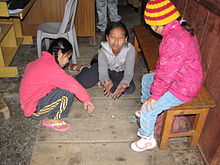- Knucklebones
-
Knucklebones also known as astragaloi, hucklebones, dibs, dibstones, jackstones, chuckstones or five-stones, is a game of very ancient origin, played with five small objects, originally the "knucklebones" (actually the astragalus: a bone in the ankle, or hock[1]) of a sheep, which are thrown up and caught in various ways. Modern knucklebones consist of six points, or knobs, proceeding from a common base, and are usually made of metal or plastic. The winner is the first player to successfully complete a prescribed series of throws, which, while of the same general character, differ widely in detail. The simplest consists in tossing up one stone, the jack, and picking up one or more from the table while it is in the air; and so on until all five stones have been picked up. Another consists in tossing up first one stone, then two, then three and so on, and catching them on the back of the hand. Different throws have received distinctive names, such as riding the elephant, peas in the pod, and horses in the stable.
The origin of knucklebones is closely connected with that of dice, of which it is probably a primitive form, and is doubtless Asiatic. Sophocles, in a fragment, ascribed the invention of knucklebones (astragaloi) to Palamedes, who taught them to his Greek countrymen during the Trojan War. Both the Iliad and the Odyssey contain allusions to games similar in character to knucklebones, and the Palamedes tradition, as flattering to the national pride, was generally accepted throughout Greece, as is indicated by numerous literary and plastic evidences. Thus Pausanias mentions a temple of Fortune in which Palamedes made an offering of his newly invented game.
According to a still more ancient tradition, Zeus, perceiving that Ganymede longed for his playmates upon Mount Ida, gave him Eros for a companion and golden dibs with which to play, and even condescended sometimes to join in the game (Apollonius[disambiguation needed
 ]). It is significant, however, that both Herodotus and Plato ascribe to the game a foreign origin. Plato (Phaedrus) names the Egyptian god Thoth as its inventor, while Herodotus relates that the Lydians, during a period of famine in the days of King Atys, originated this game and indeed almost all other games except chess. (Herodotus, History, Book I)
]). It is significant, however, that both Herodotus and Plato ascribe to the game a foreign origin. Plato (Phaedrus) names the Egyptian god Thoth as its inventor, while Herodotus relates that the Lydians, during a period of famine in the days of King Atys, originated this game and indeed almost all other games except chess. (Herodotus, History, Book I)There were two methods of playing in ancient times. The first, and probably the primitive method, consisted in tossing up and catching the bones on the back of the hand, very much as the game is played today. In the Museum of Naples may be seen a painting excavated at Pompeii, which represents the goddesses Latona, Niobe, Phoebe, Aglaia and Hileaera, the last two being engaged in playing at knucklebones. According to an epigram of Asclepiodotus[disambiguation needed
 ], astragali were given as prizes to schoolchildren, and we are reminded of Plutarch's anecdote of the youthful Alcibiades, who, when a teamster threatened to drive over some of his knucklebones that had fallen into the wagonruts, boldly threw himself in front of the advancing team. This simple form of the game was generally played only by women and children, and was called pent alit ha or five-stones. There were several varieties of it besides the usual toss and catch, one being called tropa, or hole-game, the object having been to toss the bones into a hole in the earth. Another was the simple and primitive game of odd or even.
], astragali were given as prizes to schoolchildren, and we are reminded of Plutarch's anecdote of the youthful Alcibiades, who, when a teamster threatened to drive over some of his knucklebones that had fallen into the wagonruts, boldly threw himself in front of the advancing team. This simple form of the game was generally played only by women and children, and was called pent alit ha or five-stones. There were several varieties of it besides the usual toss and catch, one being called tropa, or hole-game, the object having been to toss the bones into a hole in the earth. Another was the simple and primitive game of odd or even.The second, probably derivative, form of the game was one of pure chance, the stones being thrown upon a table, either with the hand or from a cup, and the values of the sides upon which they fell counted. In this game the shape of the pastern-bones used for astragaloi, as well as for the tali of the Romans, with whom knucklebones was also popular, determined the manner of counting. The pastern-bone of a sheep, goat or calf has, besides two rounded ends upon which it cannot stand, two broad and two narrow sides, one of each pair being concave and one convex. The convex narrow side, called chios or the dog counted I; the convex broad side 3; the concave broad side 4; and the concave narrow side 6.
Four astragali were used and 35 different scores were possible at a single throw, many receiving distinctive names such as Aphrodite, Midas, Solon, Alexander, and, among the Romans, Venus, King, Vulture, etc. The highest throw in Greece, counting 40, was the Euripides, and was probably a combination throw, since more than four sixes could not be thrown at one time. The lowest throw, both in Greece and Rome, was the Dog.
Contents
The modern game
In modern play, the player attempts a series of challenges. The official rules include:
- Over hand ones, twos, threes, fours—first "jockey" then eliminate all you have caught except one. Throw this one up and whilst it is in the air quickly pick one (two, three, or four) up off the ground, and then catch the one you threw up. Repeat with remaining knucklebones. You are able to sweep the knucklebones prior to picking them up.
- Scatter ones, twos, threes, fours—Scatter all five, select and pick up one, throw it up and without "sweeping" proceed as above.
- Dumps—hold five knucklebones in the palm, then dump them in a heap on the ground. Select one which you must take away without disturbing any others. Throw this one up, pick up other four, and catch the first one.
- Overhand scatter ones, twos, threes, fours—first "jockey" then proceed to scatter remaining knucklebones.
- Clicks—first "jockey" then proceeded as with over hand ones. When catching the one you threw up the knucklebones must click.
- No click—same as above but knucklebones must not click
- Little jingles—first "jockey", continue as over-hand ones, but keep all jacks caught in your hand at all times (including those caught while jockeying).
- Big jingles—same as above but all jacks must be thrown up each time.
- Juggles—First "jockey". If you say catch one, you throw the three in the air and whilst they are in the air pick up another, thrown that second one up, then catch the first, then catch the second. Proceed until all the jacks have been completed.
- Horse in the stable—First "jockey". Then put the tips of your five fingers of one hand on the ground, so as to make four arches. If, in "jockey" you catch say two, you put one in the 'stable' formed by your hand. Throw the other one up and whilst it is up 'sweep' another jack through one of the arches so that it stays in the stable. You can 'sweep' as many times as you like. Proceed until all 4 are stabled (each jack MUST go through a different arch!) When the 4 are in the stable take the hand away throw the fifth jack in the air and whilst it is up pick up the four and catch the fifth.
- Through the arch—As above, but only make one arch with the thumb and forefinger, and allow only one 'sweep' to get each jack through.
- Over the line—First "jockey". Place your (left)hand down on the ground. Put all the jacks caught except one, on the left side of the hand. Throw your jack up in the air and whilst it is up quickly move a jack from the right to the left hand side of the hand. Do this until all four jacks are on the left side and try and keep them together. There must be no sweeping. When the four jacks are in the position to throw the fifth up and pick up the other four and catch the fifth.
- Over the jump—as above except your put you hand vertically on its edge instead of on the ground so it makes it harder.
- Thread the needle—Same as above except the jacks have to be dropped through a circle made by the thumb and forefinger that is held about 8 inches from the ground. Once all have gone through—pick them up.
- Eggs in the basket—Same as above except the your hand is cupped palm up to form the basket, the jacks have to be placed in the "basket" without clicking, as this will break the eggs
- Catching flies—As 'scatter ones' but the catch must be done with a quick snatching downward movement making it much harder than the ordinary system of catching with palms upwards.
Other challenges include:
- Down the chute
- In the cave
- Playing golf
- This is the house that Jack built—The house that jack built is when you separate your knuckle bones into a square form. Then you go around the square with your finger saying this is the house that jack built then you throw it up in the air catch it and put it in the middle. but if you land in an empty space, your turn is over.
- Camels—Lie the 5 jacks on the ground in a row so there are no gaps between them. Then move the second one to the end, the fourth one to the end and then pick up the second one from the end. Jockey this one onto the back of your hand. Then pick a finger to use and with the jack on the back of your hand move the finger in and out and around the jacks on the ground without touching them or dropping the one on the back of your hand. Once you have weaved through them all, throw the one on the back of your hand into the air and pick up ALL of the others (in one movement), and catch the fifth.
- Picking Apples
- Car Parks
- Boats in the harbour—The same as "Horse in the stable" except hand is flat to the ground with fingers wide apart.
- Cut the cabbage—The same as "catching flies" except instead of a downward swipe, a horizontal swipe is performed when catching the jack—as if a whole cabbage is in front of the player and is being sliced through the middle.
- Flush the Toilet—Like "Big Jingles" except you must hit the ground twice (flush the toilet) each time you throw the knucklebones up.
See also
References
- ^ FN David. Games, Gods and Gambling: A history of probability and statistical ideas. London: Charles Griffin & Co., 1962. rpt New York; Dover, 1998. p 2.
External links
 This article incorporates text from a publication now in the public domain: Chisholm, Hugh, ed (1911). Encyclopædia Britannica (11th ed.). Cambridge University Press.Categories:
This article incorporates text from a publication now in the public domain: Chisholm, Hugh, ed (1911). Encyclopædia Britannica (11th ed.). Cambridge University Press.Categories:- Children's games
Wikimedia Foundation. 2010.



